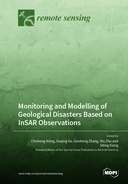Explore

Monitoring and Modelling of Geological Disasters Based on InSAR Observations
0 Ungluers have
Faved this Work
Login to Fave
Interferometric synthetic aperture radar (InSAR) has demonstrated its potential in monitoring geological disasters, e.g., in relation to subsidence, landslides, earthquakes, and volcanoes. Such monitoring results provide significant information for further physical modeling, driving mechanism interpretation, developments in early warning technology, and the management and formulation of policies by relevant authorities and stakeholders. This reprint focuses on monitoring and modelling of geological disasters using InSAR observations. The content covers topics such as PS/DS processing, deformation parameter inversion, motoring deformation (e.g., earthquakes, volcanoes, and oil extraction), and driving mechanism interpretation. These excellent reports significantly contribute to further developments in the monitoring and modeling of geological disasters using InSAR techniques.
This book is included in DOAB.
Why read this book? Have your say.
You must be logged in to comment.
Rights Information
Are you the author or publisher of this work? If so, you can claim it as yours by registering as an Unglue.it rights holder.Downloads
This work has been downloaded 69 times via unglue.it ebook links.
- 69 - pdf (CC BY) at Unglue.it.
Keywords
- accuracy analysis
- ALT
- Altyn Tagh Fault
- Anak Krakatau volcano
- ankang airport
- asymmetry interseismic strain
- Bayesian theory
- Climate Change
- coseismic displacement
- CSK images
- Dalian Jinzhou Bay International Airport
- dataset calibration
- deformation monitoring
- distributed scatterers (DSs)
- DS-InSAR
- ERA5
- error elimination
- expansive soil
- fault inversion
- FCNInSAR
- FLAC3D
- geodetic earthquake catalogue
- ground deformation
- ground fissure
- Groundwater
- high-precision coseismic deformation
- InSAR
- InSAR time-series
- interferometric synthetic aperture radar (InSAR)
- land deformation
- land subsidence
- land uplift
- landslide
- leveling
- MINE
- Model
- multi-polarization
- permafrost
- Persistent Scatter Interferometry (PSI)
- persistent scatterers (PSs)
- phase optimization
- Pollution & threats to the environment
- PS-InSAR
- PSInSAR
- quadratic polynomial fitting
- rupture model
- SBAS-InSAR
- seismic hazard
- Shanghai Lingang New City
- Singular Spectrum Analysis (SSA)
- small-to-moderate earthquakes
- SoilGrids
- source inversion
- spatiotemporal evolution characteristics
- stability analysis
- strong motion
- Su-Xi-Chang area
- subsidence monitoring
- subsidence prediction
- Synthetic Aperture Radar (SAR)
- Terzaghi consolidation theory
- thaw settlement coefficient
- the crustal movement observation network of China
- The environment
- the Nobuyuki Otsu (OTSU) method
- time series deformation
- time-series InSAR
- tropospheric delay correction
- urban construction
- variance component estimation weighting (VCE)
- viscoelastic
- VWC
- Wuhan city
- Yangbi MW 6.1 earthquake
Links
DOI: 10.3390/books978-3-0365-6381-7Editions

